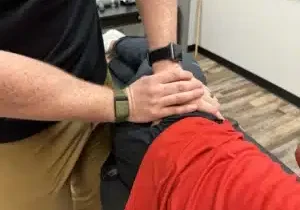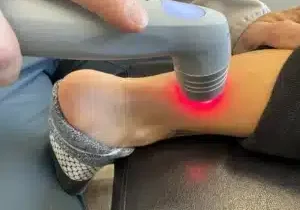At Head 2 Toe Spine and Sports Therapy, we work to empower you to with tools and exercises you can do on your own to keep your body healthy and moving well. Two of those tools we teach our patients to use are RockFloss and RockTape to help with movement dysfunction and pain.
What causes movement dysfunction?
Movement dysfunction is generally caused either by issues with your soft tissue or joints, or a problem with your stability motor control. Soft tissues are considered muscle, fascia, nerves, tendons, and ligaments. When soft tissues are injured, the result is the formation of scar tissue or adhesions to patch the damage. When torn, the tissue’s rope-like structure changes and the fibers heal in an unorganized pattern like a tangled ball of yarn and lack elasticity.
Scar tissue can form in three ways:
1) It just quietly builds up over time. I call this microtrauma. This is what happens to most athletes. You won’t know this is happening until one day that structure starts hurting and then it becomes an acute injury.
2) You hurt yourself (take a fall, sprain an ankle, etc.), or some other acute injury. I call this microtrauma.
3) Hypoxia, meaning your muscles are ultra-tight, which restricts blood flow and oxygen to the area. This causes cell death, fibroblastic proliferation (these are the cells that produce healing and scar tissue), and free radical proliferation which leads to the production of fibrous adhesion.
Pay attention to your pain
Pain is the last signal we get when something is wrong, and it changes the way we move in the short and long term. The arrival of pain means that soft tissue injury has progressed. Now you have inflammation, swelling, joint effusion and immobility which will all compromise neuromuscular coordination, timing and control. This is a big problem for an athlete.
Much of the pain and dysfunction athletes deal with is a result of poor movement. Usually by the time these problems have been brought to your attention, just correcting your exercise mechanics is not likely to change the problem. Often, the movement problem that is not even in your conscious control.
Training through pain will give you a disadvantage in your sport. Dysfunctional movement complicated by pain does not allow for the authentic and sustainable creation of strength.
Pain killers get you back into training, but motor control and reflex stabilization is compromised, reaction times are down, and you are not at your best. Pain alters movement in the short term. However, when left untreated, movement may continue to be altered long after pain is resolved.
DO NOT ignore pain, it is a warning sign. DEAL WITH IT BEFORE YOU ARE OUT OF THE GAME.
So, what to do about it?
Here are a couple of great tools to you to slow down the injury process, improve movement and improve performance: RockTape and RockFloss! Although the names are similar, their applications are quite different. Becoming familiar with the uses and techniques for each tool will help you know which is right for you.
Your Guide to RockFloss
RockFloss is a stretchy, reusable and easily portable band that is used for just a few minutes at a time. This tool is used to increase movement, reduce pain, reducing swelling, and increase profusion to tissues.
RockFloss Uses:
- It reduces swelling by creating compression. Wrap the RockFloss band at up to 50% tension over the swollen region.
- It promotes fascial and tissue glide. Wrap the RockFloss band with up to 70% tension over the target tissue. Sport-specific tasks can be completed (such as squats, run throughs, etc.) while the skin and superficial tissue is restricted in its movement by the compression of the band. Moving your limb while using RockFloss means the deeper structures are still required to glide, potentially creating an internal shearing effect within the tissue.
- It increases profusion of blood to tissues. Garbage in, groceries out.
- It brings awareness to your tissues by increasing proprioception. This means you become more conscious of your body’s mechanics and movement.
- Great for blood flow restriction training.
RockFloss General Rules:
- RockFloss bands should generally be applied from distal (furthest down the limb) to proximal (higher up the limb). Wrapping in this direction will have less pressure on the veins’ valves. The pressure will move blood towards the heart, avoiding back-pressure on the venous valves.
- The RockFloss band is generally overlapped by approximately half its width as it is wrapped up the limb.
- RockFloss is generally left in place for 2-5 minutes, depending on your tolerance, and should always be removed if any undue discomfort is felt or discoloration noted.
Your Guide to RockTape
RockTape is a one-time use kinesiology tape applied directly to the skin and left in place for a few days. It is designed with a stretch in a one-directional plane. When applied, RockTape lifts the tissues to increase blood flow which speeds recovery.
RockTape Uses:
- It increases lymphatic drainage and reduce inflammation.
- It decompresses the tissues and reduces swelling. It is likely that by decompressing the skin and the layers of tissue beneath it, lymphatic ducts and blood vessels can clear fluid more efficiently, resulting in often-dramatic changes.
- It increases fascial glide to help you push or pull tendons and ligaments in the right direction.
- It increases proprioception and feedback to the muscles, so you can turn down muscles or turn them up at a neurological level.
Tips for Applying RockTape:
- Use approximately 4 cm of the RockTape as anchors at each end of the tape. Apply these anchors without any tension.
- Don’t touch the adhesive if possible and avoid creases in the tape.
- Use scissors to round the edges of tape to avoid the RockTape lifting away from the skin too early.
- Apply directly over your painful area along the muscle fibers, using multiple strips if necessary.
- Stretch the RockTape at about 25% tension but no more than 50% to avoid skin irritation.
- Gently rub the tape after application to activate the adhesive.
- If your skin becomes red and irritated, remove the RockTape immediately. It might be an allergic reaction.
- RockTape can be worn for up to 5 days, although exposure to water may reduce that time.
Our experts are at your service
Our skilled team at Head 2 Toe Spine and Sports Therapy is here to help you move pain-free and achieve all your physical goals.
Our staff will take a look at how you are currently moving and coach you how to move better. We can teach you personal techniques with tools like RockFloss and RockTape for your specific needs.
If you have pain that is old or new, you will know you are getting the exact right treatment, not too much, not too little, but just what you need to feel great again. Call us at (425) 776-2936 or visit our New Patients page to learn more.
How Manual Therapy Can Be Your Key to Pain Alleviation and Overall Wellness
Discover the transformative power of manual therapy for pain alleviation and wellness in our blog ‘How Manual Therapy Can Be Your Key to Pain Alleviation and Overall Wellness’.
Read MoreThe Role of Chiropractic Care in Sports Injury Rehab: A Deep Dive
Explore the essential role of chiropractic care in sports injury rehab in our comprehensive blog ‘The Role of Chiropractic Care in Sports Injury Rehab: A Deep Dive’.
Read MoreHow Your Local Chiropractor Can Help You With Back and Neck Pain
Understanding back and neck pain Back and neck pain can be caused by poor posture, muscle strain, injury, or underlying health conditions. The pain may range from mild to severe and can affect your daily activities. Common symptoms include stiffness, muscle spasms, and limited range of motion. In some cases, the pain may radiate to…
Read MoreRehabilitation Services for Sports Injuries: A Comprehensive Guide
Understanding sports injuries and the need for rehabilitation services Injuries during sports are common and can affect athletes of all levels. Rehabilitation services play a crucial role in helping athletes recover from these injuries and get back to their peak performance. With the right guidance and treatment, athletes can regain strength, flexibility, and mobility, ultimately…
Read MoreUnderstanding Posture Therapy: Techniques and Benefits
What is posture therapy? Posture therapy involves exercises and techniques to improve your body alignment and position. It aims to correct postural imbalances and relieve pain and discomfort caused by poor posture. The therapy focuses on strengthening muscles and stretching tight areas to achieve proper alignment of the body. It can also include education on…
Read MoreThe Science Behind Foot Pain Therapy: Understanding the Basics
What causes foot pain? The most common cause of foot pain is wearing ill-fitting or unsupportive footwear. High heels and narrow toe boxes can put excessive pressure on the feet, leading to issues like bunions and corns. Flat feet or high arches can also contribute to foot pain because they affect the alignment and distribution…
Read More





